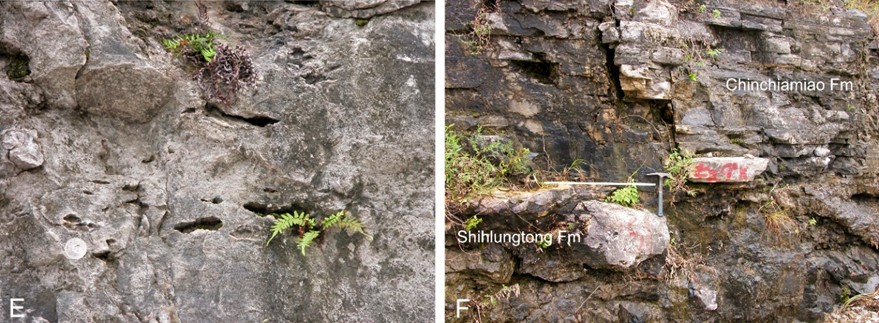Chinchiamiao Fm
Type Locality and Naming
The type section of Chinchiamiao Formation is the Damoshishan Hill section, lying about 1 km west of Qinjiamiao, or about 15 km north of the seat of Yichang City (111°15’14” E, 30°50’05” N). The section was remeasured by Wang et al. (1987). In the type section, the formation is 217.68 m thick. The Chinchiamiao Formation was named by Wang (1938). The name is derived from Chinchiamiao (spelled Qinjiamiao in Hanyu Pinyin) Village in Yiling District, Yichang City, western Hubei Province. Wang (1938) originally called the formation Chinchiamiao thin-bedded limestone. Subsequently it was renamed Chinchiamiao Group by Lu (1962), and Chinchiamiao Formation by Li (1981). Wang et al. (1987) returned the name of the unit to Chinchiamiao Group by following Lu (1962), whereas Wu et al. in Chen and Jin (1996) adopted Qinjiamiao Fm for the unit, an invalid synonymous name spelled with Hanyu Pinyin.
Lithology and Thickness
The Chinchiamiao Formation is a carbonate sequence, consists mainly of dolomite. In the type section, the formation is divided into eleven lithologic beds, from bottom up: 1‒4, grey, greyish white, thin-bedded dolomite with interbeds of thick-bedded dolomite and a few of thin-bedded dolomite in the upper part and a layer of gravel-bearing dolomite at top (50.94 m); 5, greyish white, thin-bedded dolomite bearing chert-bands or chert-lumps (41.58 m); 6, grey, thin- to medium-bedded dolomite, alternated with thin-bedded muddy dolomite and siliceous layer in part, characterized by developing ripple marks (55.5 m); 7‒8, greyish white limestone in the lower part and greyish white, thin-bedded dolomite alternated with muddy dolomite (18.51 m); 9‒11, grey, light grey, thin-bedded calcareous dolomite, alternated with greyish white or light yellow, thin-bedded calcareous and argillaceous dolomite, characterized by developing ripple marks, and with a layer of arkose-quartzite sandstone at base (51.15 m).
Relationships and Distribution
Lower contact
The Chinchiamiao Fm is in conformable contact with the underlying Shihlungtong Fm (see Figure for their contact relationship).
[ Figure: E, close-up views of the dolomite of Shihlungtong Fm; F, the contact relationship between the Shihlungtong Fm and the overlying Chinchiamiao Fm. Diameter of the coin on E = 24 mm.]
Upper contact
The Chinchiamiao Fm is in conformable contact with the overlying Loushankuan Fm
Regional extent
The Chinchiamiao Formation is exposed in the Yangtze Area of South China Region, distributed widely over western Hubei Province, including the East Yangtze Gorges, the Shennongjia area, the area of Jingshan Range-Dahongshan Mountain, and continuously stretches westward to the eastern section of Dabashan Mountain. In the area of Zigui County on the western limb of Huangling anticline, western Hubei, the Chinchiamiao Formation, about 120~140 m thick, is basically similar in lithologic character with that observed at the type section but contains more chert-bands or chert-lumps. In the Dahongshan Mountain, the lower and middle parts of the formation changed in facies into purplish red and yellowish grey silty dolomite intercalated with dolomite, brecciated muddy dolomite, pelitic siltstone, and siliceous bands with thickness varied considerably, from 42 m up to 500 m, i.e., it is 42 m thick at Wenxiakou in Zhongxiang County, 122 m at Zhujiayu in Nanzhang County, and 500 m at Xiayukou in Changyang County.
GeoJSON
Fossils
The Chinchiamiao Formation yields trilobites Schopfaspis, Xingrenaspis, Solenoparia, Annomocarella and Amphoton.
Age
Depositional setting
Additional Information
